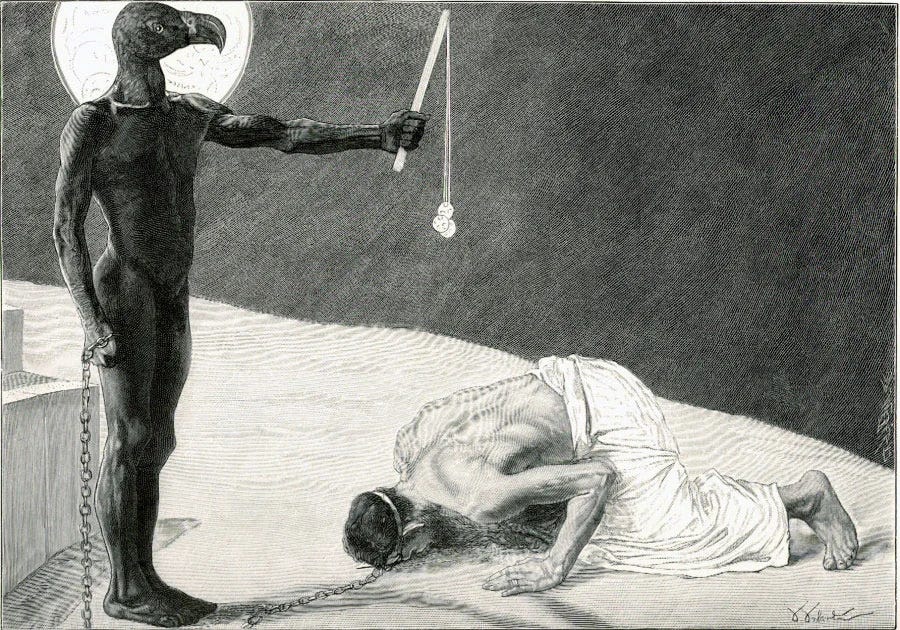Into The Void
Is the West now pagan - or something else entirely?
Inside the Colosseum, in central Rome, stands a giant cross. Erected in 2000 by Pope John Paul II to commemorate the thousands of Christians martyred there, it’s not what you might expect to see on visiting the building once known as the Flavian Ampitheatre, named for the Imperial dynasty which built it.
The building of the Colosseum was overseen by the father-and-son Emperors Vespasian and Titus, to celebrate the destruction of Jerusalem, which they had personally directed. In response to the rebellion known as the Great Jewish Revolt, which began in 66AD, Titus, who was not yet Emperor, (he would later succeed Vespasian for a few short years before probably being murdered by his brother Domitian, who succeeded him) laid siege to Jerusalem, putting the city and its Second Temple to the torch. To hammer home his victory, he enslaved thousands of Jewish prisoners and took them back to Rome, where they were forced to build the Colosseum. Titus had his victory commemorated in style on a triumphal arch that still stands, not far from the remains of his family’s amphitheatre.
I visited the Colosseum this summer. It was as crowded as I expected - which is to say that it was barely possible to move - but it was bigger than I had imagined. The sheer scale of the stones that Titus had his Jewish slaves shift (while quietly bedding the Jewish queen Berenice) was astonishing. The fact that, two thousand years on, it is one of the most recognisable ruins in the world probably ought to tell us something. But what?
This question wandered around my head as I wandered around Rome. What is it about ancient Rome that still speaks to us? Why has everybody heard of Nero, Julius Caesar and Marcus Aurelius? Why do we all still know, two millennia later, about Roman baths, gladiators, straight roads, centurions, Vestal virgins and the Colosseum? It’s a fascinating question, and while I was in Rome, I developed my own theory about it. I like to spend my holidays developing spurious and lightly-evidenced theories about human culture while I drink my espresso. It’s my idea of fun. This time around, my theory was simple and unoriginal: the Roman empire never actually ended.
Yes, Rome itself ‘fell’ to barbarian invaders in the fifth century, but that, as every Orthodox Christian knows even if no-one else does, was not the end of the Roman Empire, which by then already had a new capital in Constantinople. There was a Roman Emperor reigning until that city fell to the Ottomans in 1453, which was when the Empire technically ended. But that’s not really what I’m talking about. What I mean is that today’s ‘West’ is really just Rome under another name. Not just because the Western Christian Church was and is quartered in the old Imperial city, and behaved like an imperial power itself for much of the Middle Ages. Not just because, for that reason, ‘the West’ was in many ways ruled from Rome until the modern period. It’s something bigger than that, and yet also more nebulous. It’s the fact that, despite the Christian or pseudo-Christian, veneer, Western culture still really has many of the same values as those of Rome.
True, we don’t take slaves anymore, or throw people to lions, or crucify them, and all that is due to the legacy of the most famous man ever to be crucified. But we’re still, in some ways, Roman. We still valorise power and straight lines. We still have Emperors, even if we call them Presidents, and we still have Empires, even if we pretend we don’t. We still build vast amphitheatres for entertainment, even if the entertainment is an AC/DC concert or a Premier League match instead of a lions-vs-slaves face off. We still use Corinthian columns to demonstrate our social status. And we still make endless films and write endless books about the Romans - rather than, say, the Greeks or the Babylonians or the Assyrians or the Ottomans - because, deep down, we think we are their heirs.
Very near to the Colosseum, you can also visit the ruins of the Forum and the Palatine Hill, which are much less crowded. This vast site includes the ruins of Domitian’s massive Imperial Palace, as well as the remains of numerous temples to a mindboggling array of gods. The sheer scale and diversity of Roman paganism over the centuries is on display here, and it’s a fascinating sight.
It’s a hot one, too. Walking around the Forum in summer will take it out of you. Fortunately, there is a cafe on the site. I took my children into it to buy a refreshing drink, and came out with some more evidence to back up my half-formed holiday theory. The young woman behind the counter, who took my money with a cheery smile, was covered in tattoos and piercings, but this wasn’t what made her stand out. That stuff is barely worth mentioning in the 2020s. It was her T-shirt that said the quiet part out loud, and it was quite a contrast to the optimistic cross which peered over the lip of the massacredome next door.
On the woman’s chest was emblazoned a giant inverted pentagram. In case you were in any doubt as to what this was supposed to convey, the words below it read: DEICIDE 666.
‘That will be twenty Euros please’, she said, still smiling. Being English, I smiled back.
Keep reading with a 7-day free trial
Subscribe to The Abbey of Misrule to keep reading this post and get 7 days of free access to the full post archives.



